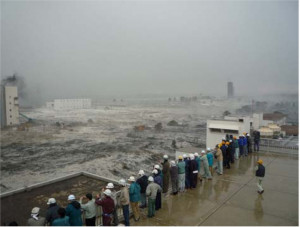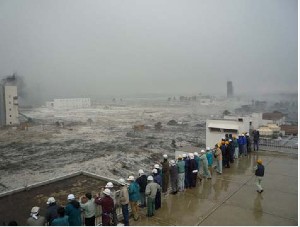A mega-tsunami (10 m of run up), caused by a major earthquake (Mw = 9, the great Tohoku earthquake) flooded at 3:50 pm the largest waste water treatment plant of Sendai city (700,000 population equivalents) located 700 meters from the sea front. In accordance with safety procedure, the 101 employees and subcontractors present took refuge on the roof the administrative building which is compliant with the latest seismic standards. At 4:50 pm, the station is completely flooded by 10 meters of sea water as the seawall behind the station has been submerged by the tsunami waves which also spread by the mouth of the bordering river. Employees were trapped on the roof overnight while a snowstorm was in progress. Then next morning, they were evacuated to a safe place by an helicopter of the self defense forces. Most of the station mechanical, electrical and electronic equipment have been destroyed by the flooding, equipement foundations and roads were eroded by the ebb tides of the tsunami. The amount of damage is estimated at 800 million of euros (2011) and the total rehabilitation was only planned 4 years after the disaster. To minimize the organic pollution of water bodies around the station, a minimum emergency treatment (chlorine tablets) has been established after primary settling in the first weeks, and a mobile system of primary sludge drying a month after the disaster.
To protect the station from future tsunamis, the station operator planned to line treatment tanks and channels with concrete, to improve the water resistance of ground-floor sensitive electrical equipment and place the buildings’doors and windows parallel to the likely incoming direction of the tsunami.





